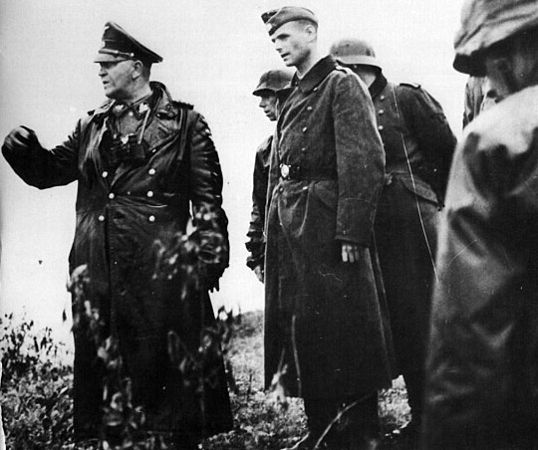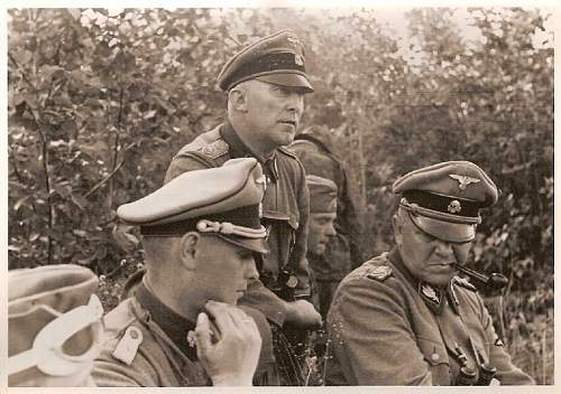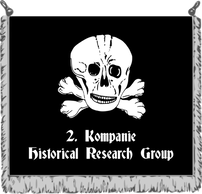awards
|
promotions
|
Early life and military service
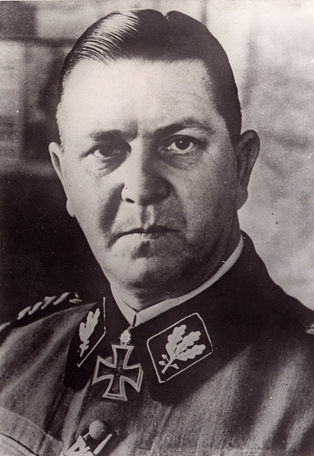
Eicke, the son of a station master, was born in Hudingen (Hampont), near Château-Salins (then in the German province of Elsass-Lothringen) into a lower-middle-class family. The youngest of 11 children, he did not do well in school and dropped out at the age of 17 before graduation. He joined the 23rd Bavarian Infantry Regiment as a volunteer. He won the Iron Cross, Second Class in 1914 for bravery.
Eicke resigned from his position of army paymaster in 1919. He began studying in his wife's hometown of Ilmenau. However, he dropped out of school again in 1920 intending to pursue a police career. He initially worked as an informer and later as a regular policeman. His career in the police came to an end because of his fervent hatred for the Weimar Republic and his repeated participation in violent political demonstrations. He finally managed to find work in 1923 at IG Farben.
Nazi activist Eicke's views on the Weimar Republic mirrored those of the Nazi Party, which he joined, along with Ernst Röhm's SA on 1 December 1928. He left the SA in August 1930 for the SS, where he quickly rose in rank after recruiting new members and building up the SS organization in the Bavarian palatinate. In 1931, Eicke was promoted to the rank of SS-Standartenführer (colonel) by Reichsführer-SS Heinrich Himmler.
Eicke resigned from his position of army paymaster in 1919. He began studying in his wife's hometown of Ilmenau. However, he dropped out of school again in 1920 intending to pursue a police career. He initially worked as an informer and later as a regular policeman. His career in the police came to an end because of his fervent hatred for the Weimar Republic and his repeated participation in violent political demonstrations. He finally managed to find work in 1923 at IG Farben.
Nazi activist Eicke's views on the Weimar Republic mirrored those of the Nazi Party, which he joined, along with Ernst Röhm's SA on 1 December 1928. He left the SA in August 1930 for the SS, where he quickly rose in rank after recruiting new members and building up the SS organization in the Bavarian palatinate. In 1931, Eicke was promoted to the rank of SS-Standartenführer (colonel) by Reichsführer-SS Heinrich Himmler.
His political activities caught the attention of his employer and in early 1932 he was laid off by IG Farben. At the same time, he was caught preparing bomb attacks on political enemies in Bavaria for which he received a two year prison sentence in July 1932. However, due to protection received from Franz Gürtner, who would later serve as minister of justice under Adolf Hitler, he was able to flee to Italy on orders from Heinrich Himmler.
In March 1933, less than three months after Hitler's rise to power, Eicke returned to Germany. Eicke had political quarrels with Gauleiter Joseph Bürckel, who had him arrested and detained for several months in a mental asylum.[4] Also during the same month, Himmler set up the first official concentration camp at Dachau. Hitler had stated that he did not want it to be just another prison or detention camp. In June 1933, Himmler obtained the release of Eicke from the asylum and promoted him to an SS-Oberführer.
On 26 June 1933, Himmler appointed him commandant of Dachau after complaints and criminal proceedings against former commandant SS-Sturmbannführer Hilmar Wäckerle following the murder of several detainees under the "guise of punishment". Eicke requested a permanent unit and Himmler granted the request; the SS-Wachverbände (Guard Unit) was formed.
Promoted on 30 January 1934 to SS-Brigadeführer , Eicke as commander of Dachau reorganized the camp. Eicke devised a system that was used as a model for future camps throughout Germany. He established new guarding provisions, which included rigid discipline, total obedience to orders, and tightening disciplinary and punishment regulations for detainees. Uniforms were issued for prisoners and guards alike; the guards' uniforms had a special death's head insignia on their collars. Eicke detested weakness and instructed his men that any SS man with a soft heart should "...retire at once to a monastery". Eicke's anti-semitism and anti-bolshevism as well as his insistence on unconditional obedience towards him, the SS and Hitler made an impression on Himmler.In May 1934, Eicke claimed the title of Concentration Camps Inspector for himself.
In March 1933, less than three months after Hitler's rise to power, Eicke returned to Germany. Eicke had political quarrels with Gauleiter Joseph Bürckel, who had him arrested and detained for several months in a mental asylum.[4] Also during the same month, Himmler set up the first official concentration camp at Dachau. Hitler had stated that he did not want it to be just another prison or detention camp. In June 1933, Himmler obtained the release of Eicke from the asylum and promoted him to an SS-Oberführer.
On 26 June 1933, Himmler appointed him commandant of Dachau after complaints and criminal proceedings against former commandant SS-Sturmbannführer Hilmar Wäckerle following the murder of several detainees under the "guise of punishment". Eicke requested a permanent unit and Himmler granted the request; the SS-Wachverbände (Guard Unit) was formed.
Promoted on 30 January 1934 to SS-Brigadeführer , Eicke as commander of Dachau reorganized the camp. Eicke devised a system that was used as a model for future camps throughout Germany. He established new guarding provisions, which included rigid discipline, total obedience to orders, and tightening disciplinary and punishment regulations for detainees. Uniforms were issued for prisoners and guards alike; the guards' uniforms had a special death's head insignia on their collars. Eicke detested weakness and instructed his men that any SS man with a soft heart should "...retire at once to a monastery". Eicke's anti-semitism and anti-bolshevism as well as his insistence on unconditional obedience towards him, the SS and Hitler made an impression on Himmler.In May 1934, Eicke claimed the title of Concentration Camps Inspector for himself.
dachau and the totenkopfdivision
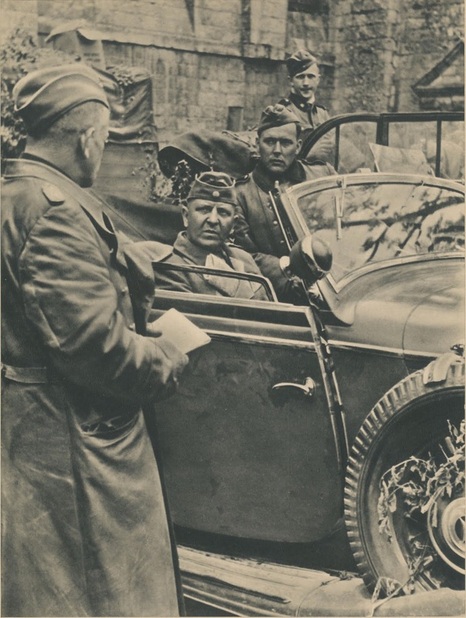
In early 1934, Hitler and other Nazi leaders became concerned that Ernst Röhm, chief of the SA, was planning a coup d'état. Hitler decided on 21 June that Röhm and the SA leadership had to be eliminated. The purge of the SA leadership and other enemies of the state began on 30 June in an action which became known as the Night of the Long Knives.
Eicke along with hand-chosen members of the Dachau concentration camp guards assisted Sepp Dietrich's Leibstandarte SS Adolf Hitler to arrest and imprison SA commanders. After Röhm was arrested, Hitler gave him the choice to commit suicide or be shot. When Röhm refused to kill himself, he was shot dead by Eicke (together with his adjutant, Michael Lippert) on 1 July 1934.
Shortly thereafter, Himmler officially named Eicke chief of the Inspektion der Konzentrationslager (Concentration Camps Inspectorate or CCI) and promoted him to the rank of SS-Gruppenführer in command of the SS-Wachverbände. As a result of the Night of the Long Knives, the remaining SA-run camps were taken over by the SS.
In his role as the Concentration Camps Inspector, Eicke began a large reorganisation of the camps in 1935. The smaller camps were dismantled. Dachau concentration camp remained, then Sachsenhausen concentration camp opened in summer 1936, Buchenwald in summer 1937 and Ravensbrück (near Lichtenburg) in May 1939.
Further, in 1935, Dachau became the training center for the concentration camps service. On 29 March 1936, the concentration camp guards and administration units were officially designated as the SS-Totenkopfverbände (SS-TV). Eicke's reorganizations and the introduction of forced labour made the camps one of the SS's most powerful tools; this earned him the enmity of Reinhard Heydrich, who had already unsuccessfully attempted to take control of the Dachau concentration camp in his position as chief of the SD. Eicke prevailed with support from Himmler.
At the beginning of World War II, the success of the Totenkopf's sister formations the SS-Infanterie-Regiment (mot) Leibstandarte SS Adolf Hitler and the three Standarten of the SS-Verfügungstruppe led to Hitler approving Himmler's recommendation for the creation of three Waffen-SS divisions in October 1939.
SS-Division Totenkopf was formed from concentration camp guards of the 1st (Oberbayern), 2nd (Brandenburg) and 3rd (Thüringen) Standarten (regiments) of the SS-Totenkopfverbände,and soldiers from the SS-Heimwehr Danzig.
Eicke was given command of the division.
The Totenkopf Division went on to become one of the most effective German fighting formations on the Eastern Front, often serving as "Hitler's firemen", rushed to the scene of Soviet breakthroughs. During the course of the war, Eicke and his division became known for brutality and several war crimes, including the murder of 97 British POWs in Le Paradis in 1940, the murder of captured Soviet soldiers and the plundering and pillaging of several Soviet villages. The Totenkopf continued to show ferocity, during the advance in 1941 as well as the summer offensive in 1942, the conquest of Kharkov, the defense of the Demyansk Pocket, the defense of Warsaw, and Budapest in 1945.
Death
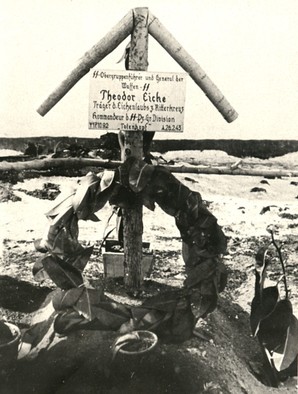
Eicke was killed on 26 February 1943, several months after being promoted to SS-Obergruppenführer. While performing a battlefield reconnaissance during the opening stages of the Third Battle of Kharkov, his Fieseler Fi 156 Storch was shot down by Soviet troops 1 kilometre southwest of Artelnoje (near Lozovaya). An assault group from the division recovered the bodies of Eicke, the pilot and SS-Hauptsturmführer Friedrich from enemy territory.
Eicke was portrayed in the Axis press as a hero, and soon after his death one of the Totenkopf's infantry regiments received the cuff-title Theodor Eicke.
Eicke was originally buried at a German military cemetery near Orelka, Russia. Later, Himmler ordered Eicke's remains dug up and reburied at the Hegewald German military cemetery in Zhitomir. In 1944, the Germans were pushed back and forced to retreat yet again. Eicke's corpse was left where it had been re-buried.
DISCLAIMER: 2. Kompanie is a non-political organization We do not support naziism, or fascism. We are not associated with nor do we condone the actions of the Third Reich or the actual 3.SS Division.
